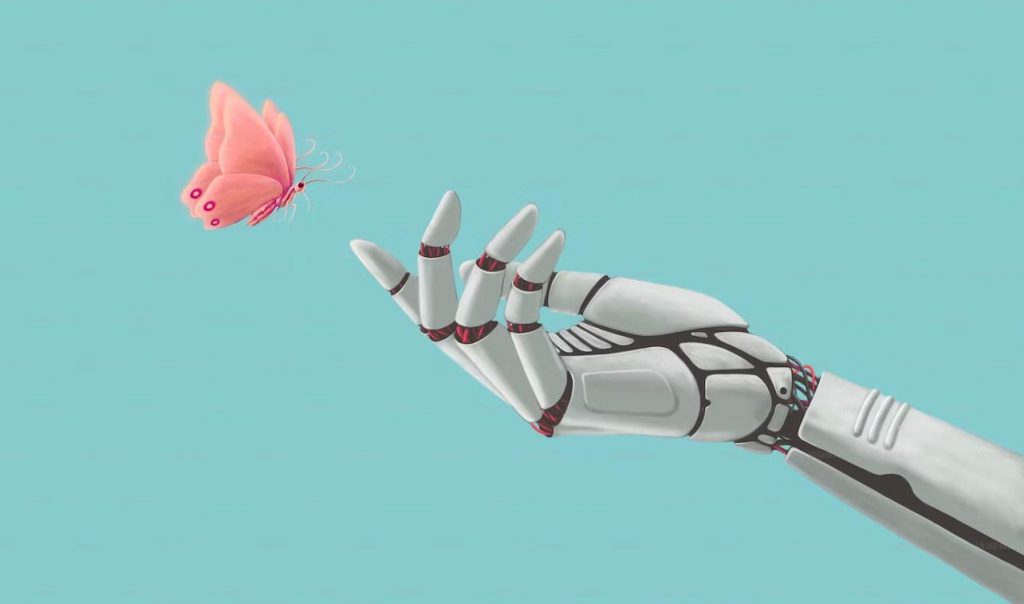Welcome to WordPress. This is your first post. Edit or delete it, then start writing!
Category: Uncategorized
-

15 Strategic Tech Trends for 2025 That Will Change the World
The world is changing faster than we can get used to. What was surprising yesterday is now being implemented in hospitals, businesses, stores, and homes. Artificial intelligence doesn’t just generate texts — it heals, edits videos, analyzes risks, and helps designers. And 2025 can definitely be called the year when countries began to build “sovereign AI” and launch a new space economy.
In this article, we’ll highlight 15 technological changes that are already shaping the new reality. We’ll look at examples from different countries to better understand the scale and direction of the movement. And even if some trends seem distant, they’re already knocking on the doors of business, education, and medicine.
AI is moving from hype to practical tools
Just a few years ago, AI was associated with fun: drawing pictures or generating text. In 2025, it is already a full-fledged player – not in the future, but in the present. Businesses are automating routine processes, countries are launching national AI development programs, and technology giants are competing for the palm in creating the most powerful model.
What has changed?
- The price of 1 million GPT-4 tokens fell from $36 to $0.25, making AI accessible even to startups.
- Anthropic’s Claude 3.5 Sonnet model achieves over 76% accuracy on challenging tasks, outperforming even GPT-4o.
- Alibaba’s China Qwen2.5 is ranked number one in the world for open models on Hugging Face .
And also…
- The US, China, Australia, Belgium and Brazil have increased their AI funding by 2-5 times over the past year. For example, in Brazil, investment growth was 471%.
- Companies like Walmart have already integrated generative AI into daily processes, from updating product catalogs to making personalized recommendations to customers.
China Develops AI and Challenges the US
While American companies compete for AI supremacy, China is rapidly closing the gap. And it’s doing so confidently: with government support, billions in investment, and an ambition to create an alternative to Western models.
Now Chinese products are not just local solutions, but world-class players.
Qwen and Yi models top the world rankings
In the open rating of the Hugging Face platform, Chinese models are already on par with GPT-4, Claude and Mistral. The following stand out:
- Qwen (by Alibaba) is a multilingual, open-source model that is easy to customize;
- Yi (by 01.AI) is powerful, fast, and already shows great results in reasoning and coding tasks.
They are no longer just used in China – they are becoming attractive to developers around the world who are looking for an open and competitive alternative to American solutions.
AI is part of China’s national strategy
Unlike the West, where AI development is a matter for private companies, in China it is a national issue. The state:
- allocates resources to AI education and science,
- actively supports AI startups,
- oversees development activities related to safety and ethics.
Trust in AI is the new currency of the future
Artificial intelligence has learned to generate texts, write code, and even consult. But can we trust it completely? As AI penetrates medicine, education, and public administration, the demand for explanation of decisions and transparency of models is growing.
The “black box” problem
Most large models today are “black boxes”: they produce results but do not explain the logic behind them. This creates tension in sensitive areas – when it is not convenience that is at stake, but life or justice. Therefore, AI must not only be intelligent, but also understandable.
Who is already working on this?
Key market players are actively seeking solutions:
- Anthropic in the Claude 3.5 model emphasizes the interpretability of answers by adding step-by-step reasoning.
- OpenAI is exploring how models form their conclusions – in partnership with the academic community.
- Google DeepMind is implementing self-checking mechanisms that highlight the logic behind a model’s response.
These efforts are not just technical progress, but an attempt to turn trust in AI into a systemic value. If you are interested in understanding how to work with AI — and how it can be used in a profession that is the future, we invite you to our upcoming events . Choose an online course that will help you master a modern specialty and confidently move towards new opportunities.
The Transition to Sovereign AI
More and more countries are moving from consuming global AI services to creating their own ecosystems. Sovereign AI is not just a matter of digital independence, but a strategic step for security, economy, and development. States want to control data, influence algorithms, and develop local talent.
Who is already building their own AI systems?
A number of countries are not waiting for global solutions – they are creating their own:
- Belgium launches national open AI platform for government agencies.
- Brazil is investing in its own LLM models for use in education and healthcare.
- South Korea is developing neural networks in the Korean language with an emphasis on local queries.
- Italy has opened a state-run AI development center based at a university community.
These are examples of a new approach: AI as a state-level infrastructure, not just a commercial tool.
Nvidia is the engine of local ecosystems
Nvidia has become not only a graphics card manufacturer, but also a key player in the creation of national AI hubs . It provides cloud solutions, servers, and complete tech stacks for local AI deployment. With these tools, countries can build AI independently — and faster.
Small Open Source Models Are the Weapon of Startups
Not all companies can afford to use GPT-4 or Claude in full. But the good news is that open-source small language models (SLMs) are becoming a powerful alternative — accessible, flexible, and significantly cheaper . They are opening the door to AI for startups and small businesses.
Meta, Mistral, Microsoft — Drivers of Openness
Several players have made open AI a reality:
- Meta, with the LLaMA 3 model, has created one of the highest quality open-source platforms for local execution.
- Mistral AI entered the market with compact models that are not inferior to larger ones in many tasks.
- Microsoft supports the development of open models in its Azure infrastructure, making it easier for teams without their own servers to get started.
This is a new round of competition: not only the smartest one wins, but also the most accessible one.
AI Becomes Economically Achievable
The price of entry into the world of AI is rapidly decreasing. For example, GPT-4o mini costs only $0.25 per million tokens, which opens up opportunities for prototyping, customization, and scaling even with a minimal budget. Startups can launch their own AI assistants, internal chatbots, content generators – without overpaying for a “big license” . AI has become not only smart, but also financially feasible.
Spatial Computing – A New Era
When the digital and physical worlds begin to merge, we talk about spatial computing. These technologies allow you to work with information as if it were “alive” in the space next to you . Already today, these solutions are moving beyond experiments and into everyday life.
Leaders in spatial technologies
A group of innovative companies has already formed on the market:
- Apple Vision Pro sets a new bar for visual experiences in virtual and augmented reality.
- Meta Quest 3 is actively promoted in the gaming, educational and collaborative spheres.
- Google Project Starline allows you to communicate via “3D video conferencing” – as if the person were right next to you.
Where does this already work?
Spatial computing is changing not only the interface, but also the way of thinking. It is no longer futurism – spatial technologies are used in real tasks:
- In medicine , for example at Boston Children’s Hospital, to simulate complex surgeries.
- In architecture and the automotive industry , in particular GM, to visualize projects in real scale.
- In education , to create inclusive and deep learning experiences.
- Spatial computing changes not only the interface, but also the way we think.
Immersive learning is the new standard for companies
Lecture- and presentation-based training is gradually becoming a thing of the past. It is being replaced by simulation training, augmented reality, and 3D scenarios that engage employees in the process more deeply, quickly, and interestingly. This is not just a new form of delivery — it is a change in the corporate development paradigm.
Technologies that transform learning
Global companies are already implementing immersive tools:
- Microsoft HoloLens enables training in AR environments: from engineering to medicine.
- NVIDIA Omniverse models manufacturing and team processes in 3D space.
- Companies are using VR headsets, simulators and interactive environments to provide training in realistic settings.
Not only are these formats more effective, they are also more memorable and create a positive impression of the process itself. Immersive technologies are changing not only the approach to learning, but also the way we interact with brands. Read more about this in the article “10 Key Trends That Will Change Digital Marketing in 2025” .
Master a modern digital profession
See upcoming events from Genius.Space, choose a convenient program and leave a request for participation
More than 50% of market leaders are already in the game
According to analytics, more than half of Fortune 100 companies already use immersive learning in their internal programs. This includes staff training, crisis drills, security training, technical skills, and soft skills. Companies are investing in experiences, not just information — and it’s working.
Medical Revolution Thanks to AI
Artificial intelligence is already changing medicine not in theory, but in practice. Algorithms do not simply analyze symptoms — they help identify diseases at early stages, when the chances of recovery are much higher. This applies to the most complex diagnoses: depression, oncology, Alzheimer’s disease.
Where does this already work?
These programs do not replace a doctor, but they help make decisions faster, more accurately and more effectively. A number of companies have already brought AI solutions to the market:
- Lucem Health (USA) – uses AI to analyze medical data and signals about potential risks.
- Sensely (Switzerland) – virtual medical assistants that interact with patients 24/7.
- Ubie (Japan and India) – AI platforms for primary diagnostics that are already used in hospitals.
What’s next?
AI is gradually being integrated into every stage of medical care, from screening to treatment. Its ability to work with large amounts of data gives doctors more confidence and support in difficult situations. And perhaps in the near future we will not be talking about “medicine of the future,” but about a new norm — with AI nearby.
Retail and personalization – 1:1 in real time
Classic mailings and banners no longer work as they used to . Modern buyers want to receive offers that exactly match their interests, desires and the moment. That is why retail is massively moving towards AI personalization in real time.
How does it work for market leaders?
Major players have introduced AI assistants into the purchasing process:
- Walmart uses chatbots and visual assistants that suggest products based on previous purchases.
- Target creates personalized selections right in the app, responding to requests in real time.
- Amazon adapts the main page, recommendation blocks, and even prices to each user individually.
Personalization hurts efficiency
According to research, personalized recommendations are three times more effective than mass campaigns. Viewers ignore such offers less often, click more often and buy faster. For brands, this is not a trend, but a new standard in customer communication.
Generative AI in e-commerce
Text descriptions, recommendations, visuals, chat responses — none of this is written manually anymore. In 2025, generative AI will completely change e-commerce, automating processes that used to take hours. This not only saves time, but also scalable personalization for thousands of products at a time.
How does this work in real companies?
E-commerce leaders have already integrated AI into their catalogs, allowing them to respond to trends in real time — without having to hire a full team of marketers.
- Walmart has updated over 850 million product descriptions using Large Language Models (LLM).
- Generating name variants , selecting tags, SEO texts – all this is done by a ChatGPT-like assistant.
- Other companies create visuals, banners , even recommendation carousels using generative models.
AI as a buyer’s assistant
Modern online stores do not just sell — they consult, advise, even entertain. AI assistants answer questions, help choose a size, combine things into an image or choose a gift . And all this — in real time, in a dialogue, without human intervention.
A New Leap Forward in Pharmaceuticals: RNA Therapies
Just a few years ago, RNA technologies seemed like a distant future. Today, RNAi, mRNA, and ASO are already being actively used to treat diseases that were considered incurable. This is a real breakthrough that is changing the approach to medicine at the cellular level.
How do RNA therapies work?
Unlike classic drugs, RNA technologies work at the level of genetic information. They can block “incorrect” proteins, trigger necessary processes, or correct genetic errors. This opens up new ways to treat cancer and rare genetic syndromes.
Who is already implementing it?
RNA therapies are becoming the basis of a new generation of pharmaceuticals – more precise, effective and personalized. Leading companies are no longer just testing these technologies – they are already producing real drugs:
- Alnylam (USA) develops RNAi drugs for the treatment of nervous and cardiovascular diseases.
- Vico Therapeutics (Netherlands) is working on ASO solutions for genetic disorders.
- Chinese biotech companies are actively developing next-generation mRNA vaccines.
Space has become closer
Until recently, space was exclusively the domain of states and scientific agencies. But in 2025, the situation has changed dramatically – private companies are actively exploring orbit, launching satellites, testing new formats of logistics and communications . Technologies that seemed like science fiction yesterday are becoming business.
Who dictates the pace?
Today, the leaders in space launches are not governments, but corporations:
- SpaceX carries out more than 70% of all US launches.
- Starlink provides satellite internet to dozens of countries, including remote regions.
- New startups are creating solutions for cargo transportation, construction in orbit, and deployment of mini-stations.
The private sector has not only caught up with NASA, it is setting the pace and commercial sense of space exploration.
New Horizons in Infrastructure
A separate industry is orbital data centers, which operate without the need for cooling and with minimal data transfer delays. There are also developments underway for orbital refueling systems and space manufacturing, which will allow components to be created without returning to Earth. Space is becoming not a goal, but a medium for innovation.
The New Data Center Boom
AI applications require not only powerful models, but also stable infrastructure. In 2025, the world is experiencing a real boom in the construction of data centers, which are becoming the backbone of the digital economy. Every request to a language model, every visualization or text generation is gigabytes of data and energy that are processed in real time.
Why is infrastructure the new priority?
The emergence of generative AI, spatial computing, and immersive learning has increased the load on servers several times over. This forces companies to invest in new types of data centers — more powerful, more stable, and more environmentally friendly. AI market leaders, cloud platforms, and governments are especially active in this area.
What is the new wave built on?
To ensure stable operation of data centers, companies are looking for alternative energy sources:
- Nuclear energy as a long-term stable solution;
- Geothermal energy as a green option with a low carbon footprint;
- Thermonuclear projects as an investment in the energy of the future.
Liquid cooling and new energy efficiency technologies
The infrastructure for AI is growing at an incredible rate , and with it, the need for server cooling. Traditional ventilation systems can no longer cope with the load, so companies are switching to liquid cooling. This is not only a more efficient but also a more energy-efficient solution, which is becoming the standard of the future.
What is liquid cooling?
Instead of simply blowing air over the servers, the system uses special liquids or water loops that effectively reduce the temperature of the equipment.
This reduces energy consumption, reduces the risk of overheating and increases server density, while the technology operates quietly and smoothly – ideal for high-load data centers.
A trend that is becoming the norm
Analysts predict that by 2026, more than 38% of data centers in the world will switch to liquid cooling . This is due not only to energy savings, but also to the environmental requirements of the market: companies are increasingly reporting their carbon footprint. Green data centers are becoming not just an image element, but a criterion for choosing a partner.
Local AI hubs in unexpected countries
Artificial intelligence is no longer just Silicon Valley . In 2025, local AI hubs will appear in countries that were not previously associated with high technology. This is a new stage of AI globalization – when each country gets a chance to create its own intellectual ecosystem.
Where is growth already happening?
The most actively developing are:
- India is creating national AI centers at universities and launching startups with global ambitions.
- Norway – Invests in green data centers and AI solutions for sustainable development.
- Brazil and Italy are forming hubs for localized AI products and support for small businesses.
In the end
Artificial intelligence is no longer a futuristic dream, but a reality that changes business, medicine, education, and even the idea of everyday things. We live in a time when technology is developing faster than we can adapt. But this is precisely where the greatest opportunity lies: the first to understand the principles of the new era will gain a real advantage. And knowledge about AI today is not a theory, but a real tool for the future.
If you want to confidently move towards a new profession, we invite you to our upcoming events . There you will be able to learn more about modern trends, communicate with mentors and choose a course that suits you. Start changing your professional life now – the future is being created today.
-

10 Top HR Tech Trends of 2025 to Refresh Your Strategy
Human resources technology, also known as HR technology, has undergone a remarkable transformation in recent years, driven by the ever-changing trends of the modern workplace. This year, the HR landscape is poised for another wave of innovation, focused on improving the employee experience, simplifying HR processes, and leveraging data-driven insights to make informed decisions. In this article, we’ll discuss the top 10 HR technology trends for 2025 and how your organization can benefit from them.

I. What is Human Resources Technology?
Human Resources Technology (HR Technology) refers to software and digital tools designed to automate, streamline, and improve HR functions such as recruiting, payroll, employee management, benefits administration, performance tracking, training, and workforce analytics. It plays a key role in optimizing workforce operations, ensuring compliance, and improving the overall employee experience.
So, what role does technology play in human resources management? HR technology simplifies complex HR processes, enabling organizations to save time, reduce errors, and improve decision-making in talent management. It also allows HR teams to focus on strategic initiatives like employee engagement, workforce planning, and career development.
Additionally, modern HR technology platforms seamlessly integrate with other business software, including accounting, communications, and project management tools, ensuring smooth and efficient cross-departmental operations.
II. Current HR Technology Trends Scenario
The HR technology landscape is constantly evolving, with new tech tools emerging for the workplace all the time. Companies that embrace these new technologies will gain a competitive advantage in recruiting, hiring, and retaining top talent.
One of the most significant HR technology trends in 2025 is the rise of artificial intelligence (AI). AI is being used to automate various HR tasks, such as screening resumes, conducting interviews, and providing employee training. AI is also being used to personalize the employee experience, such as providing employees with personalized recommendations for training and development opportunities.
Another key HR technology trend for 2025 is the increased use of data and analytics. Companies are collecting more data about their employees than ever before and using it to make better hiring, training, and development decisions. Data and analytics can also be used to identify and address potential issues like employee turnover and harassment.
III. The Most Important Trends in HR Technology in 2025
Considering the current human resources scenario, we see that many previous trends in HR technology are no longer relevant; they are here to stay and will continue to evolve. Below are the top HR technology trends we predict for 2025:
- Skills-based recruiting
- Personalized employee experience
- Remote and hybrid working model
- Employee well-being and mental health
- Developing soft skills
- Cybersecurity strengthened
- Social media and brand awareness
- Space management for human resources
- Artificial intelligence and machine learning
- Data-based decision making
1. Skills-Based Hiring: The HR Technology Trend
Traditional recruiting methods are no longer keeping pace with the pace of change in the workforce. By 2025, we expect to see a shift to skills-based hiring, which focuses on identifying and hiring candidates based on their skills and experience, rather than their educational background or job title. This approach enables organizations to find talent with practical skills aligned with business needs, reduce hiring bias, and increase workforce diversity.
HR technology can help companies promote and engage with recruiting events , assess candidate skills, and make skills-based hiring decisions. AI-powered tools can conduct skill-based assessments, analyze candidate potential, and streamline the hiring process, ensuring better matching between employers and employees.
2. Personalized Employee Experience (EX)
Employee experience (EX) is no longer a buzzword; it’s a critical business imperative. Companies that prioritize EX are more likely to attract and retain top talent, increase productivity, and improve customer satisfaction. Organizations that focus on personalizing career growth, work-life balance, and benefits will create a more engaged workforce.
HR technology can help companies personalize their outreach by offering customized solutions for employee onboarding, training and development opportunities , and creating a culture of recognition and appreciation. AI-powered platforms can offer tailored learning paths, real-time feedback, and personalized benefits packages that address individual employee needs and expectations.
3. Remote and Hybrid Working Model: HR Technology Trend
Remote and hybrid work models continue to evolve. In 2025, companies will invest more in technologies that support seamless remote collaboration, virtual meetings, and hybrid team management. Organizations that optimize their hybrid strategies will retain talent and increase employee satisfaction.
HR technology solutions help track productivity, improve communication, and optimize workspaces for hybrid teams. Tools like AI-powered scheduling assistants, virtual whiteboards, and integrated HR platforms make managing hybrid teams more efficient and enable seamless workflow transitions between remote and in-office environments.
4. Employee Health and Mental Health
Employee well-being has evolved from an optional benefit to a core component of workplace strategy. A survey by the American Psychological Association (APA) shows that over 80% of employees prioritize mental health benefits when choosing an employer. Organizations that invest in wellness initiatives experience higher employee retention, increased job satisfaction, and higher overall productivity.
In 2025, we expect a continued focus on employee well-being, with companies investing in programs and tools that support physical, mental, and emotional health. This approach not only helps with employee retention but also increases overall productivity. HR technology can help companies promote and deliver corporate events and other wellness programs in a personalized and accessible way for employees.

5. Developing Soft Skills HR Technology
In a world driven by automation, soft skills like communication, leadership, and adaptability are more important than ever. Companies are realizing that technical skills alone are not enough to succeed in today’s dynamic workplaces, and they are investing in leadership training and emotional intelligence development.
Human resources technology platforms offer e-learning programs , AI-powered coaching, and virtual mentorships to develop employees’ soft skills and enhance teamwork. Gamification and AI-based career coaching in learning modules help employees develop interpersonal skills and navigate complex workplace interactions more effectively.
6. Strengthened Cybersecurity: The Growing Role of HR Technology
As digital transformation accelerates and remote work becomes the norm, organizations are strengthening cybersecurity. HR is playing a growing role in this shift. According to IBM, the average cost of a data breach in the US reached $4.45 million in 2023. As a result, businesses are taking data protection more seriously, especially when it comes to employee information.
Forward-thinking HR teams are now prioritizing security. They work closely with IT to establish clear data protection policies. They also train their teams to recognize and respond to potential threats. HR leaders are also conducting company-wide training to foster a culture of cybersecurity awareness and accountability. Ultimately, this proactive approach not only protects individuals but also builds trust and strengthens organizational resilience.

7. Social Media and Brand Awareness: The HR Technology Trend
Being visible on social media is crucial for attracting top talent and is therefore among the main human resources technology trends. Companies are increasingly using social platforms to strengthen their employer brand, recruit candidates, and engage employees. Having a strong online presence allows businesses to showcase their workplace culture and attract candidates who align with their values.
HR tech integrates with LinkedIn, TikTok, and other networks to streamline recruiting and employer branding efforts. AI-powered social listening tools help companies monitor brand perception and engagement, allowing them to refine their strategies and create content that resonates with their target audiences.
8. Space Management Technology for Human Resources
Space management is expected to be one of the key human resources technology trends of 2025, as the interaction of people with their work environments is vital for organizations.
Given that different employees require different types of spaces based on their job roles and duties, there’s a growing demand for HR technologies that help allocate and manage these spaces efficiently. For example, a salesperson might need a meeting room to interact with customers, while a technician might need a lab or technical workspace.
HR technology solutions can greatly help in this regard by offering features such as space management , real-time visibility of space availability, enabling online space and resource booking, and providing analytics for better management of the workspace.
By doing so, HR technology can ensure employees have access to appropriate workspaces when they need them. This reduces resource waste and contributes to increased productivity, as staff members can perform their tasks without being hindered by space constraints. This interconnectedness of space and people management is paving the way for its adoption as an HR technology trend for the future.

9. Artificial Intelligence (AI) and Machine Learning (ML)
Artificial Intelligence and Machine Learning are transforming HR operations. Expect more AI-powered chatbots, machine learning-driven workforce analytics, and predictive hiring models that predict employee turnover and workforce needs in 2025. These technologies will further streamline HR processes and improve decision-making capabilities.
AI-powered HR technology solutions can automate repetitive tasks. They also provide instant employee support and predict HR trends based on historical data. By analyzing workforce patterns, AI can help HR teams proactively address challenges before they impact business performance.
10. Data-Driven Decision Making: HR Technologies
HR is now data-centric. Companies are leveraging real-time workforce analytics to make strategic decisions about talent acquisition, performance management, and employee engagement. Data-driven HR strategies are helping companies optimize workflows, increase employee satisfaction, and foster a more productive workforce.
HR technology enables HR teams to track key performance indicators (KPIs), identify patterns, and optimize workforce strategies. AI-powered analytics tools provide insights into workforce trends, allowing HR professionals to predict organizational needs and adapt policies accordingly.

IV. How Can Timely Software Complete Your HR Tech Stack?
Companies are encouraged to adopt powerful HR technology tools to improve organizational performance and culture. Timely software provides comprehensive solutions tailored to HR departments, enabling better productivity, interaction, and coordination of activities.
- Event Success: Timely’s event management software helps companies effectively organize internal and external events, such as job fairs and corporate functions .
- Training Management: Timely’s training management software helps HR teams streamline training awareness and planning. It also allows companies to promote training courses and collect registrations directly through their website or intranet.
- Space Reservations: Effective space management is essential in hybrid workplaces. Timely’s space management system can help optimize space usage. By enabling employees to book rooms online, companies can reduce administrative tasks and better utilize available space.
If you’re looking to take advantage of all the latest HR technology trends, Timely is the perfect tool for you. Timely has been recognized as a Category Leader by GetApp and ranked among the best Records Software solutions based on user reviews.